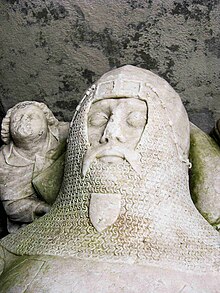Tudur ap Goronwy (c. 1310 - c. 1367) was a Welsh landowner, soldier and administrator of the Tudors of Penmynydd family from the island of Anglesey.
Tudur ap Goronwy | |
|---|---|
| Born | c. 1310 |
| Died | c. 1367 |
| Resting place | Llanfaes Friary |
| Occupation | Royal officer |
| Spouse | Marged ferch Tomos |
| Children | |

Origins
editBorn about 1310, he was one of the two sons of Goronwy ap Tudur Hen and his wife Gwerfyl ferch Madog. His father had fought for King Edward I of England and had stayed loyal to King Edward II of England. On his father's death in 1331, he inherited the family lands which had passed down from his grandfather Tudur Hen and lived in the village of Trecastell.[1]
His brother and ally, Hywel ap Goronwy (died about 1366), joined the priesthood, becoming a canon of Bangor Cathedral, and eventually Archdeacon of Anglesey.[2]
Career
editHe was a royal officer for the island of Anglesey and served in the English army of King Edward III of England during the campaigns in France in 1337.[1]
In 1345 he and his brother Hywel were involved in a prominent murder case, probably the result of local unrest. Henry Shalford, newly appointed as the Prince of Wales' representative in North Wales, was attacked and killed near Hywel's house in Bangor by a band of men led by Tudur.[3] One report suggested that Shalford knew too much about malpractice among leading Welshmen.[4] The result was panic among the English inhabitants of the area and suspicion of the Welsh community.[3] Both brothers were arrested and placed in custody,[1] with Hywel held at Launceston in Cornwall and Tudur in Chester, but both were eventually released without charge or penalty.[3] This led to complaints by English residents that "no Welsh man dare indict them" because of their local influence. Gruffydd ap Maredudd ap Dafydd suggested that the brothers were as strong as oak trees and protected all those under their branches.[5] In 1352, both were in peaceful possession of their ancestral lands in Anglesey.[3]
Tudur was buried in the south wall of the chancel at the Franciscan friary of Llanfaes near Bangor, Gwynedd.[5] The bodies of his ancestors were nearby, in the south wall of the chapel.[1] The bard Iolo Goch composed an elegy to him.
Family
editThe Welsh genealogies show Tudur ap Goronwy marrying twice, to Mallt ferch Madog, daughter of Madog ap Iorwerth, and to Marged ferch Tomos, daughter of Tomos ap Llewelyn and aunt of rebel Owain Glyndŵr,[1] and having six sons:[6]
- Goronwy ap Tudur;
- Rhys ap Tudur (by Mallt);
- Ednyfed ap Tudur;
- Gwilym ap Tudur;
- Rhys ap Tudur (by Marged);
- Maredudd ap Tudur.
All rose to positions of power locally on Anglesey and in the adjoining areas of North Wales. Both Rhys and Gwilym accompanied King Richard II of England on his expedition to Ireland in 1398 and, after he was deposed, Rhys, Gwilym and Maredudd were supporters of the Welsh uprising of their cousin Owain Glyndŵr against King Henry IV of England.[7]
Maredudd's son Owain, known in English as Owen Tudor, became the grandfather of King Henry VII of England.[8][9][10]
Lineage
edit
| |||||||||||||||||||||||||||||||||||||||||||||||||||||||||||||||||||||||||||||||||||||||||||||||||||||||||||||||||||||||||||||||||||||||||||||||||||||||||||||||||||||||||||||||||||||||||||||||||||||||||||||||||||||||||||||||||||||||||||||||||||||||||||||||||||||||||||||||||||||||||||||||||||||||||||||||||||||||||||||||||||||||||||||||||||||||||||||||||||||||||||||||||||||||||||||||||||||||||||||||||||||||||||||||||||||||||||||||||||||||||||||||||||||||||||||||||||||||||||||||||||||||||||||||||||||||||||||||||||||||||||||||||||||||||||||||||||||||||||||||||||||||||||||||||||||||||||||||||||||||||||||||||||||||||||||||||||||||||||||||||||||||||||||||||||||||||||||||||||||||||||||||||||||||||||||||||||||||||||||||||||||||||||||||||||||||||||||||||||||||||||||||||||||||||||||||||||||||||||||||||||||||||||||||||||||||||||||||||||||||||||||||||||||||||||||||||||||||||||||||||||||||||||||||||||||||||||||||||||||||||||||||||||||||||||||||||||||||||||||||||||||||||||||||||||||||||||||||||||||||
Notes:
| |||||||||||||||||||||||||||||||||||||||||||||||||||||||||||||||||||||||||||||||||||||||||||||||||||||||||||||||||||||||||||||||||||||||||||||||||||||||||||||||||||||||||||||||||||||||||||||||||||||||||||||||||||||||||||||||||||||||||||||||||||||||||||||||||||||||||||||||||||||||||||||||||||||||||||||||||||||||||||||||||||||||||||||||||||||||||||||||||||||||||||||||||||||||||||||||||||||||||||||||||||||||||||||||||||||||||||||||||||||||||||||||||||||||||||||||||||||||||||||||||||||||||||||||||||||||||||||||||||||||||||||||||||||||||||||||||||||||||||||||||||||||||||||||||||||||||||||||||||||||||||||||||||||||||||||||||||||||||||||||||||||||||||||||||||||||||||||||||||||||||||||||||||||||||||||||||||||||||||||||||||||||||||||||||||||||||||||||||||||||||||||||||||||||||||||||||||||||||||||||||||||||||||||||||||||||||||||||||||||||||||||||||||||||||||||||||||||||||||||||||||||||||||||||||||||||||||||||||||||||||||||||||||||||||||||||||||||||||||||||||||||||||||||||||||||||||||||||||||||||
References
edit- ^ a b c d e Griffiths & Thomas 1985, p. 18.
- ^ Griffiths & Thomas 1985, p. 17.
- ^ a b c d Carr, A. D. (23 September 2004). "Tudor family, forebears of (per. c. 1215–1404)". Oxford Dictionary of National Biography (Subscription or UK public library membership needed). Oxford Dictionary of National Biography (online ed.). Oxford University Press. doi:10.1093/ref:odnb/77357. (Subscription or UK public library membership required.)
- ^ J. G. Edwards, ed., Calendar of Ancient Correspondence Concerning Wales, 1935, 233
- ^ a b Griffiths & Thomas 1985, p. 19.
- ^ Peter Bartrum. "Marchudd 13". Prosiect Bartrum/Bartrum Project. Aberystwyth University.; Peter Bartrum. "Rhirid Flaidd 03". Prosiect Bartrum/Bartrum Project. Aberystwyth University.; Peter Bartrum. "Rhys ap Tewdwr 07". Prosiect Bartrum/Bartrum Project. Aberystwyth University.
- ^ Griffiths & Thomas 1985, pp. 20–21.
- ^ Griffiths & Thomas 1985, pp. 32–35.
- ^ Nicholas 1872, p. 29.
- ^ "A royal dynasty". BBC Wales. 5 August 2008. Retrieved 21 April 2016.
Sources
edit- Griffiths, Ralph Alan; Thomas, Roger S. (1985). The Making of the Tudor Dynasty. New York: St. Martin's Press. ISBN 978-0-31250-745-9.
- Nicholas, Thomas (1872). Annals and Antiquities of the Counties and County Families of Wales. Vol. 1. London: Genealogical Publishing.